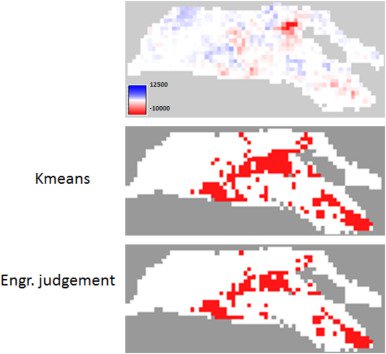This week the proceedings for ECMOR XV – 15th European Conference on the Mathematics of Oil Recovery were published. It will take place in Amsterdam from 2016-08-29 to 2016-09-01.
Naturally, there are a bunch of publication on improving history matching of models.
An Ensemble 4D Seismic History Matching Framework with Wavelet Multiresolution Analysis – A 3D Benchmark Case Study
Luo et al
Ensemble-based Seismic History Matching with Distance Parameterization for Complex Grids
Y. Zhang and O. Leeuwenburgh
These two are the most interesting to me, clearly working with 4D data. Luo et al propose to use AVA data instead of 4D inverted data for history matching, tackling the problem of big data sets by applying a discrete wavelet transform and using a threshold to ignore noise, which is usually a problem for history matching cases.
Zhang et al tackle the problem of gridding your reservoir model, as the applied matching algorithm assumes Cartesian coordinates. They decided to apply the Fast marching method to solve the Eikonal equation and therefore circumventing the problem, claiming good numerical results even in a full field model.
Discrete Fracture Method for Petroleum Reservoir Simulation Using an Element-based Finite Volume Method
Maliska et al.
The work of Maliska et al. Is my highlight of the week. This work proposes the generation of discrete fracture networks on the basis of an element-based finite volume method. The abstract reads very general and it seems this is more of an announcement of future work, I believe this might be one to watch out for. Combining well-logging, and 4D seismic to improve fracture characterization is definitely an idea I have been toying with and a path that might give some interesting insights.
On the 21st a paper came out in Computers & Geosciences:
Binary 4D Seismic History Matching, a Metric Study
Romain Chassagne et al
It explores binary seismic history matching and evaluation of metrics on a “real world geoscience problem”. The main take-aways are that local metrics outperform others and that binary filters will generally coarsen the search space. The metrics in question are:
- Hamming distance
- Hausdorff distance
- Mutual Information
- Current Measure Metric
There has been a lot published about history matching seismic data to reservoir models. Less so about 4D itself.
Jesper Dramsch
Latest posts by Jesper Dramsch (see all)
- Juneteenth 2020 - 2020-06-19
- All About Dashboards – Friday Faves - 2020-05-22
- Keeping Busy – Friday Faves - 2020-04-24


